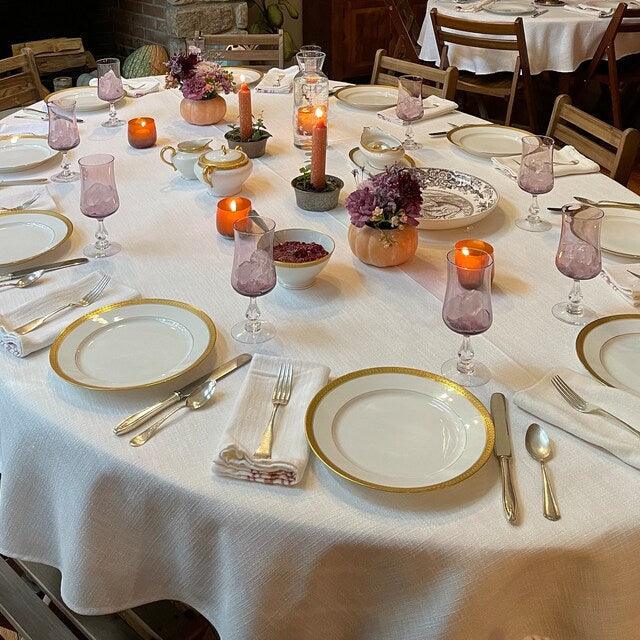Bed Linen Textile Advancements: Checking Out Modern Trends and Creative Applications in Design and Fabric Market
From sustainable manufacturing approaches to cutting-edge weaving innovations, the development of bed linen is reshaping the landscape of the fabric market. As we dive right into the worlds of imaginative style applications and the development of linen blends and crossbreed materials, a brand-new chapter unravels in which bed linen's duty in future fabric developments takes center stage.
Sustainable Practices in Linen Manufacturing
Sustainable methods in linen manufacturing have become significantly crucial in the fabric market's efforts to reduce ecological effect and promote moral sourcing techniques. Linen, a natural fiber originated from the flax plant, offers a series of advantages such as breathability, biodegradability, and toughness. However, conventional techniques of bed linen production can entail considerable water intake, chemical usage, and energy-intensive procedures.
To address these challenges, many fabric producers are embracing lasting techniques throughout the linen manufacturing process. This consists of sourcing flax from natural ranches that avoid hazardous chemicals and chemicals, implementing water-efficient retting strategies to essence fibers from the flax stalks, and using green dyes and finishes. Additionally, some business are purchasing renewable energy sources to power their manufacturing facilities and decreasing waste with recycling and upcycling campaigns.
Technological Innovations in Linen Weaving
With the expanding emphasis on sustainable techniques in linen production, the textile sector is now observing a rise in technological innovations specifically targeted at changing the art of bed linen weaving. These advancements are reshaping the method bed linen textiles are produced, offering enhanced performance, top quality, and creativity in weaving methods.
Among the vital technical advancements in bed linen weaving is the combination of digital looms. These sophisticated looms are furnished with software application that enables intricate and intricate styles to be woven with accuracy. By digitizing the weaving procedure, suppliers can achieve higher consistency and precision in their linen fabrics.
Additionally, developments in yarn spinning technology have actually allowed the manufacturing of finer and even more durable linen yarns - table cloths. This causes softer and smoother bed linen materials that keep their high quality even after numerous usages and washes
Furthermore, the advancement of green dyeing procedures and finishes for linen textiles is getting grip. These lasting techniques not only decrease the ecological impact but additionally provide to the boosting consumer need for fairly produced textiles.
Creative Design Applications for Linen
Innovative creative strategies are progressively shaping the imaginative style applications for bed linen in the textile sector. Bed linen's natural visual allure and capacity to blend with other materials make it a favored choice for creating special garments and devices that provide to the ecologically conscious consumer.
Moreover, designers are try out linen in home decor, utilizing its durable and breathable nature to craft fashionable home furnishings such as drapes, bed linen, and upholstery. The texture and drape of bed linen bring a feeling of sophistication and comfort to indoor rooms, adding a touch of beauty to modern homes.

Bed Linen Blends and Crossbreed Fabrics
:max_bytes(150000):strip_icc()/sage-teddy_46-7e12be353dfc4e69b1afc52bf5af2820.jpg)
Crossbreed fabrics, on the other hand, take the principle of blending a step even more by integrating extra components such as metal threads, recycled materials, or conductive fibers. These ingenious textiles not just increase the style possibilities but likewise present useful facets like conductivity, antimicrobial properties, or improved sturdiness. Hybrid textiles are progressively being made use of in different industries, consisting of style, interior decoration, and technological fabrics, where the need for multifunctional materials gets on the increase.
Bed linen's Duty in Future Fabric Innovations

In the world of future fabric innovations, linen is anticipated to be a key gamer in the growth of sophisticated useful textiles. Researchers and developers are discovering ways to boost linen's fundamental qualities with technological developments, such as incorporating smart fabrics, nanotechnology, and performance coatings. These technologies intend to boost linen's performance characteristics, making it ideal for a more comprehensive range of applications, from activewear to protective clothing.
In addition, the combination of bed linen with various other all-natural or synthetic fibers opens endless opportunities for developing novel fabrics with special properties and performances. By leveraging bed linen's qualities and discovering ingenious blends, the fabric market is poised to present exciting growths that accommodate progressing customer visit their website needs and sustainability requirements.
Conclusion
In verdict, the expedition of lasting methods, technological improvements, innovative layout applications, bed linen blends, and its function in future textile innovations highlight the continual evolution of linen material in the modern-day design and fabric market. With a focus on innovation and creative thinking, the convenience and eco-friendly nature of bed linen make it a useful material for suppliers and developers alike, leading the way for more advancements and innovations in the area of fabrics.
As we dive into the worlds of creative layout applications and the introduction of linen blends and crossbreed materials, a brand-new chapter unfolds in which bed linen's role in future fabric advancements takes center phase.
Checking out the fusion of linen with other materials has led to the appearance of ingenious blends and hybrid textiles in the modern textile market. Bed linen blends provide an unique mix of the qualities of bed linen with those of other fibers, resulting in materials that have enhanced properties such as boosted resilience, boosted draping, and reduced wrinkling.The evolution of bed linen blends and hybrid fabrics has actually established the stage for Bed linen to play an essential duty in driving future textile developments.In the realm of future textile advancements, linen is expected to be a crucial player in the development of sophisticated functional materials.